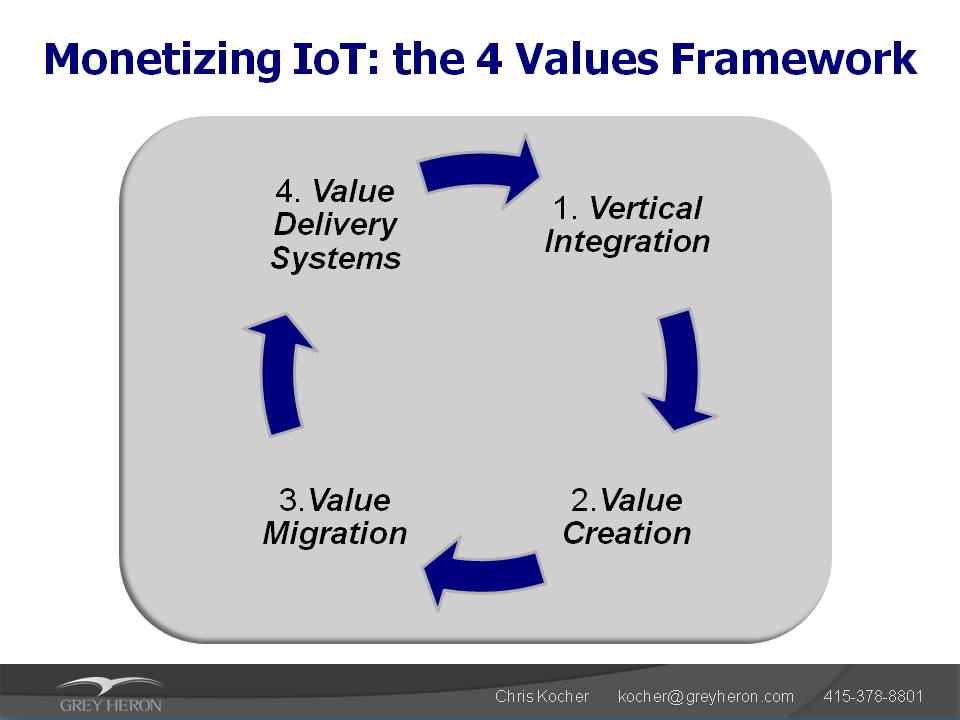
IoT: Where is the money? – Part 3
In my previous articles on monetizing IoT (Part 1 and Part 2), I described some of the key drivers of IoT, the 10 main IoT areas, the importance of ecosystems and the 4 Values Framework with a discussion of two of the framework components: vertical integration and value creation. In this Part 3 article, I’ll describe the last two components of the 4 Vs Framework: value migration and value delivery systems. This framework works for both large established companies as well as emerging startups in thinking through how they can best monetize their IoT opportunities.

Value migration
This approach to IoT monetization is about moving into adjacent markets. It is a high-risk approach with potentially enormous payout and usually limited to existing companies that are well established in one area with some core competency, technology or IP that can be used in an adjacent market or industry.
A classic example of value migration is Amazon. Originally an online retailer of books, it extended that to be an eCommerce powerhouse. Based on its experience in highly scalable, extremely reliable IT systems, it started Amazon Web Services (AWS) as a very inexpensive cloud offering. It is now the largest cloud provider by far —even compared to Microsoft and Google – with revenues of over $8 billion a year from that one source alone.
In addition, Amazon built out its back-end systems to be an ideal cloud storage and scalable compute resource to support IoT. Furthermore, its Amazon Prime entertainment service, Echo voice-recognition device and Dash buttons set Amazon up to offer products and services in the “connected-home” market where it will compete with Google, Apple, Comcast, ATT and others in that space.
In a similar value-migration approach, Google bought Nest for over a billion dollars. The Nest platform for the connected home is being extended with all types of devices starting with smoke detectors, webcams, etc. Although this is an interesting move into the adjacent connected-home market, what’s even more interesting, and potentially a much bigger opportunity, is Google moving into the energy business and competing with the utilities.
With a direct relationship with Nest thermostat owners, Google is in the position to be able to aggregate hundreds of thousands of homeowners in various regions and offer them incentives (cash back, discounts, etc.) to reduce their energy consumption on very hot or very cold days. This can smooth out loads on the energy grid that can eliminate utilities companies’ needs to buy expensive extra power on the open market for peak loads, from having to use very expensive “peaker” energy plants or, even worse, need to build entirely new energy plants for hundreds of millions of dollars.
Google will be in a position to ask for part of those savings from the utilities. By developing and maintaining the customer relationship via smartphones, mining the data and using it for incentives, Google can earn revenues in the energy market, even though it is not building any capital-intensive energy production systems.
This is a highly scalable, relatively low investment, high-margin and high-risk approach. Note: what is really new here is the business model approach, not the technology. As we work with large companies with extensive resources, we encourage them to explore these types of “home run” opportunities as they develop their IoT strategies. However, this is not recommended for most early-stage companies that don’t have extensive resources and for which a move to an adjacent market may defocus them from their core business.
Value delivery systems
If it’s “all about the bass” in music, than in IoT, it’s all about ecosystems and partnering. Companies need to provide “whole solutions” that create complete value for customers without their need to understand technology details, integrate disparate systems or suffer business complexity. Success in the IoT, as in many other areas will be dependent on a strong value delivery system where all the functions within an organization and its partners’ value chain are well aligned on customer value delivery without the disconnects that result from internal silos of responsibility.
This puts a premium on having a complete solution. Systems integrators, value-added resellers, consultants and other third parties can help act as the “glue” to hold things together. But, ultimately, those offerings that are simpler and better integrated will create less friction and be adopted sooner.
Although almost anyone in any business has a set of benefits and value propositions, unfortunately most have not really built out a well-thought-out value-delivery system. This entails thinking through every aspect of the business from internal development through delivery and post sale to customer experience. This is true whether your company does it all or third-party partners are involved. Any disconnects in delivering this value diminish the customer experience, create friction, slow adoption and ultimately reduce sales and revenues.
Uber is an example of a smooth and comprehensive value-delivery system. It has done everything to make its customer experience as frictionless and easy as possible from signing up for the service to evaluation of drivers and even referring friends for an added discount. Quick, simple, transparent, inexpensive.
But, what if Uber had decided integrating payments wasn’t necessary? Instead, riders could just use a credit card. That would have simplified and shortened its internal development work and the need for Uber to work with banks, payment processors and other partners in the value chain. It probably would have saved money and gotten to market more quickly. But from a user-experience point of view, it would be a much worse experience and potentially much more expensive for Uber in the long run.
With no integrated payment system, it would have added more time for drivers and passengers on each ride. It would introduce the likelihood of potential rejected transactions and perhaps the need to take cash, which would create revenue leakage and accounting problems. Furthermore, it would require some sort of POS / credit card reader with the attendant costs and service issues. This is just one example of ensuring an end-to-end value delivery system to create a great customer experience.
Point solutions, one-off products, stand-alone “cool toys” may appeal to a small market or niche buyers and be faster to implement. However, much of the value in IoT solutions is derived when things are networked, well integrated and comprehensive in providing a great customer experience or hard edge business value. This is why the IoT, like previous waves of innovation, will impact organization structures in which rethinking the business, silo busting or classic reengineering may be necessary to achieve real value.
8 key points for an IoT monetization strategy
Here are a few key suggestions to consider as you embark on your IoT journey and refine your strategy:
- Align with customer value.
- Consider how you can migrate value to other markets.
- Keep it simple.
- Take off your product blinders and focus on business modelinnovation.
- Don’t be a solution in search of a problem.
- Make sure your product/service is not someone else’s seeding strategy.
- Prepare to go silo busting.
- “Never mistake a clear vision for a short distance.” (Paul Saffo).